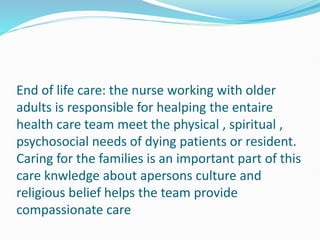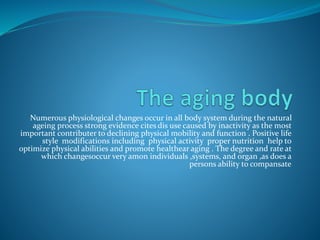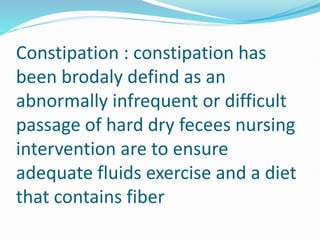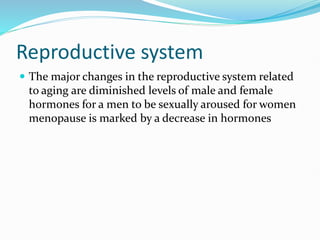CARE FOR OLD AGE ANP SEMINAR in nursing aspectanp.pptx
- 1. Who is old ?
- 2. Older adulthood begins at about age 65 and continuous until death, a possible span of 40 years or more. Older adulthood is possible to divide into the young old and the old-old adults. The term frail elderly refers to those older than 75 years of age with health concern centenarians are those older than 100 year of age
- 3. Wellness health promotion and disease prevention The compelling holistic movement of our times is changing our understanding of health to comprise a broader definition of wellness than the mere absence of disease .wellness is based on a belief that each person has an optimal level of function and that even in chronic illness and dying some levels of well being in attainable. Wellnes involve acheving a balance between an individual emotional , spiritual , social , cutural and physical state
- 4. Stresses of caregiving :older people receiving care may recent being burden feel anger and frusteration in relinquishing roles or become demanding in an attempt to regain control care givers often experience role overload finding them seles pulled in many direction . There simply may not be enough time to meetall demand
- 5. Loss grif and depression : significant psychosocial changes experienced by older adults typically include personal, social and ecnomical losses. There are role change s and retirement and loss of significant others
- 6. End of life care: the nurse working with older adults is responsible for healping the entaire health care team meet the physical , spiritual , psychosocial needs of dying patients or resident. Caring for the families is an important part of this care knwledge about apersons culture and religious belief helps the team provide compassionate care
- 7. Numerous physiological changes occur in all body system during the natural ageing process strong evidence cites dis use caused by inactivity as the most important contributer to declining physical mobility and function . Positive life style modifications including physical activity proper nutrition help to optimize physical abilities and promote healthear aging . The degree and rate at which changesoccur very amon individuals ,systems, and organ ,as does a persons ability to compansate
- 8. System wise age realated nursing concerns
- 9. Aging skin is dry and thin and losses tone and elastisity and with less fat under the skin , wrinkles becomes apparent
- 10. Moles: most moles are bening however , sun related to skin changes including precancerous actinic keratoes basal cell or squamous cell carcinoma or malignent melanoma some time develop on sun exposed have dermatologist examine any suspecious lesion
- 11. Nail abnormalities : bilateral clubbing indicate possible pulmonary or cardiac disease yellowing indicates possible fungal nfection splintering indicates possible malnutrion and pitting some times signals periferal vascular disease, psoriasis , dibetes mellitus or syphilis
- 12. Pressure ulcer: pressure ulcer are significant risk for older adults and patient with chronic disease . The best way to prevent pressure pointsby repositioning atleast every 2 hours , urine drainage ,or fecal material left in contact with the skin even or a short period will potentially cause it to become impaired . Remove urine drainage or fecal material and wash the skin rinse it with clear water and pat it dry
- 13. Good nutrion essential for health function and quality of life unfavorable outcome result from either under nutriyion or over nutrition
- 14. Obesity :obesity prudent for older adults the reduction in calories older adult need to consume quality food such as grain, vegitables, and friuts which contain vitamin, minerals , roughage and fiber to meet their daily needs with out large amount of suger and fat
- 15. Fluid and dehydration: fluids are necessary for the body to function and remove wast product of metabolism. It is important for an older person to have a minimum of 1500mlof fluid daily. Older adults some time also decrease fluid intake in order to control incntinence or due to chf. The most appropriate intervention are to make fluid readily available and toilet facilities more easily accessible and those with severe impairement often need to be assisted to drink fluids
- 16. Oral hygiene: missing teeath make chewing difficult and tring loose fitting dentures also tend to make chewing difficult and offen allow food under denture . Recommented mouth care for older adult consist of thrugh clensing of the entire mouth a soft bristled tooth brush or foam- stick-applicator in the early morning and at bedtime mouth care is also important when an older adult has dentures
- 17. Loss of appetite: older adults frequently experiences a loss of appetite changes in tast as aresult of decreased saliva production and decresed no .of taste buds some times make food un appealing . Decresed gastiric motility occur becouse of loss of muscles in the stomach . Intervention that are usually appropriate because of less taste or interast in food might include preparing the food using colour and garnshes , using attractive dishes and table settings with good lighting and bright colours
- 18. stomach becomes less efficient allowing food and digestive enzymes to flow back in to the esophagus symptoms include heartburn sourstomach and regurgitation of sour, bitter material . It is possible to control reflux by eating small meals avoiding eating before bed time and elevating the head of the bed
- 19. Food tolerance: lactose primerly found in milk is a common source of food intolerance . Diary products are an important source of calcium. Whoch needed to prevent osteoporosis in older adults . Lactose intolerance individuals need to replace milk with cheese and yogert which is processed and easier to digest.
- 20. Dysphagiya : difficulty in swallowing arises from many possible causes including a strok /other neurologic disfunction . Interventions used for positioning , verbal coching which improve ability to control swelling .
- 21. Failure to thrive : failure to thrive in older adults is characterised by refusal to eat loss of weight and lean body mass and subsequent malnutrition this is a complex situation assosiated with mental diorders such dementia and depression as well as social economic factors.
- 22. Specialized nutrional support : apatient or resident in ability to ingest, digest or absorb nutrients is in some cases an indication for enteral tube feeding . Long term use of feeding tubes contributes to incresed health risks and discomfort
- 23. Constipation : constipation has been brodaly defind as an abnormally infrequent or difficult passage of hard dry fecees nursing intervention are to ensure adequate fluids exercise and a diet that contains fiber
- 24. Fecal incontinence :the most common cause of incontinence in the older adult is fecal impaction associated with immobilization and inadequate fiber and fluid intake a digital rectal examination is sometimes required to determine the nature of the problem
- 25. Gastrointestinal bleeding: older people have less protective mucus secretion and therefore they are more susceptable to gastrointetinal bleeding . Assessfor blood in the stool for the conformation
- 26. Age related changes: overall kidney function decreases with age even with decrease of 50% . The body has adequate reserve to support normal body functions unless kidney disease present . Bladder capacity also decreases approximately 50% Assess frequency, amount, odor, color and consistency of urine
- 27. Cardiovasucular system Cardiovascular changes with ageing involve loss of structural elastisity , decreased cardiac out put , increased atherosclerosis , hypertension, coronary artery disease , periferal vascular disease , etc . Explain the risk factors and action for reducing the risk factors
- 28. Respiratory system The tissues of the lung and bronchi less elastic and more rigid with age . Nursing intervention is to assess respiratory pattern effort and luing sounds
- 29. Musculoskeletal system Ther is a gradual reduction in the number and the size of active muscle fibers and ther is decreasd muscle tone , mass , and strength ther is an alteration in equlibrium between bone deposition and resoption
- 30. Endocrine system The levels of hormones secreated and the response of body tissue to hormones , especialy hypothyroidism and diabetes mellitus , are the most common endocirine disorders in older adults
- 31. Reproductive system The major changes in the reproductive system related to aging are diminished levels of male and female hormones for a men to be sexually aroused for women menopause is marked by a decrease in hormones
- 32. Sensory perception Sensory perception sight , hearing, taste , smell, and touch are decreased perception in increased aging .
- 33. Safety and security issues for older adults
- 34. Finance : financial problems are all too possible when people have not planned carefully for retirement
- 35. Housing : housing represent a certain degree of self concept and status . It is difficult for many of us to comprehend the insecurity that older adults feel when moving from one site to another in thier later years . Some older adults choose assisted living in longterm care residence . They require more assistence than they would receive in an independent living environment . It is more expensive to live assisted living
- 36. Falls: falls are the leading cause of accidental death in individuals older than the age of 65 . Falls are possible as aresult



































